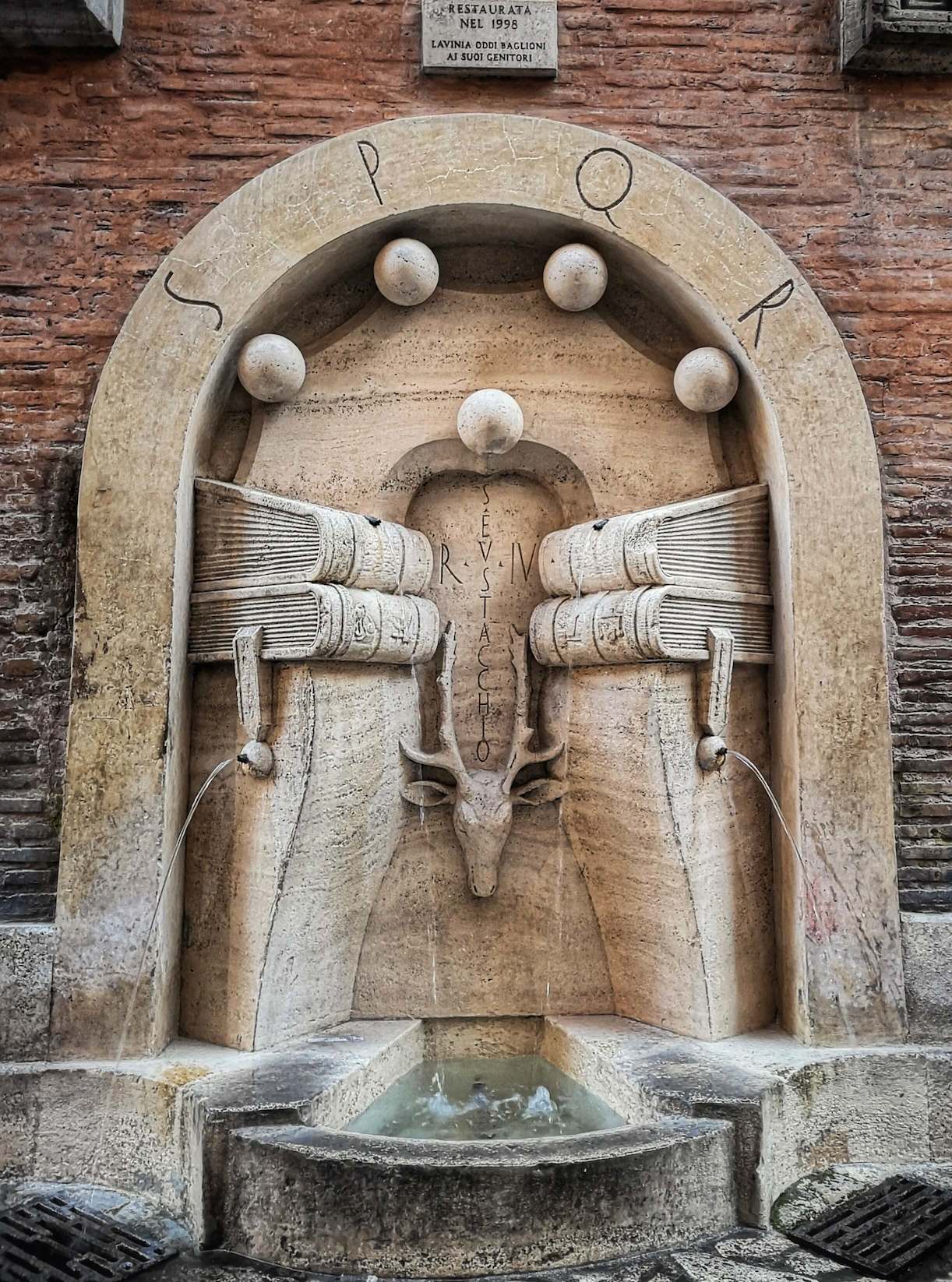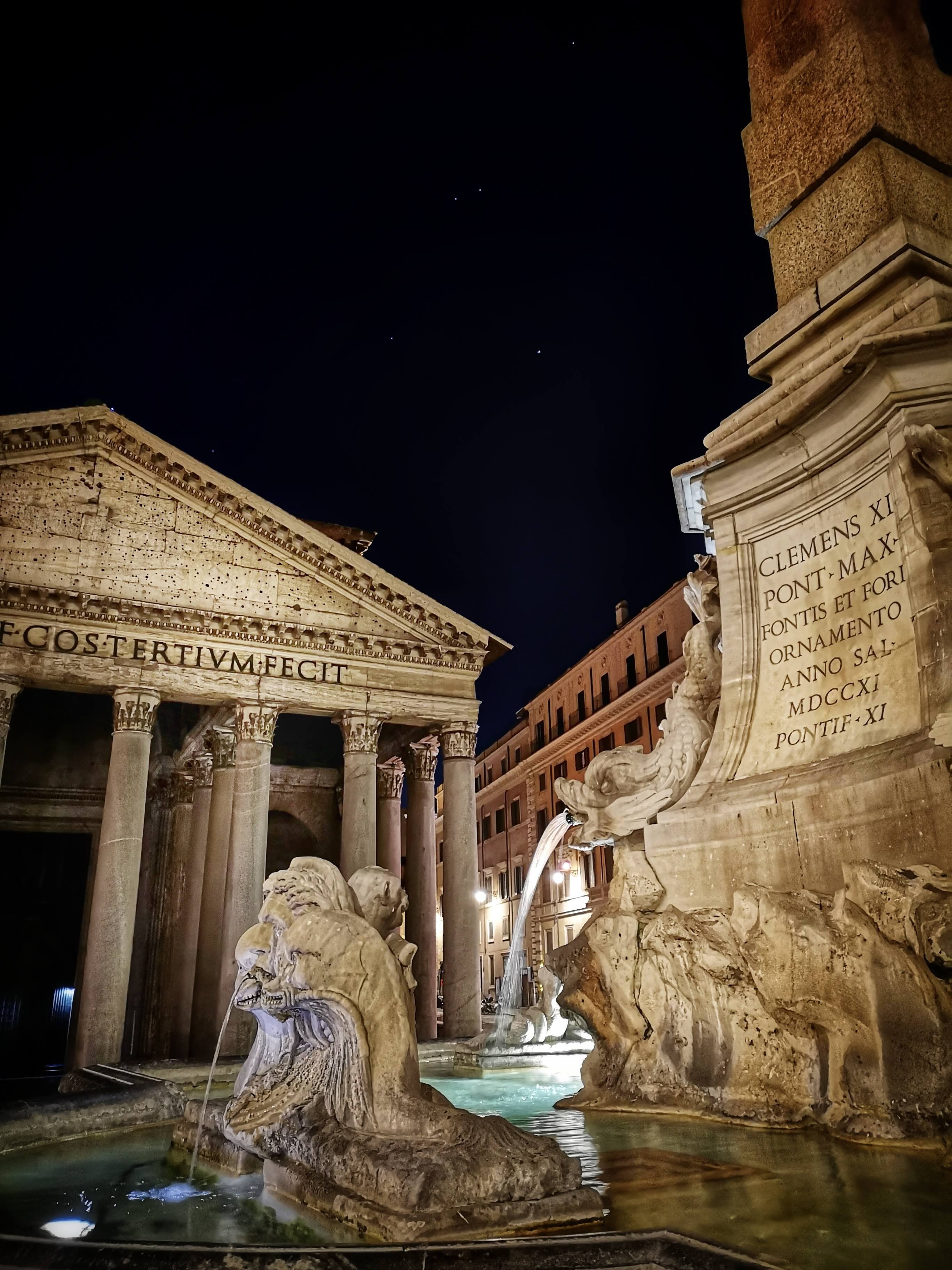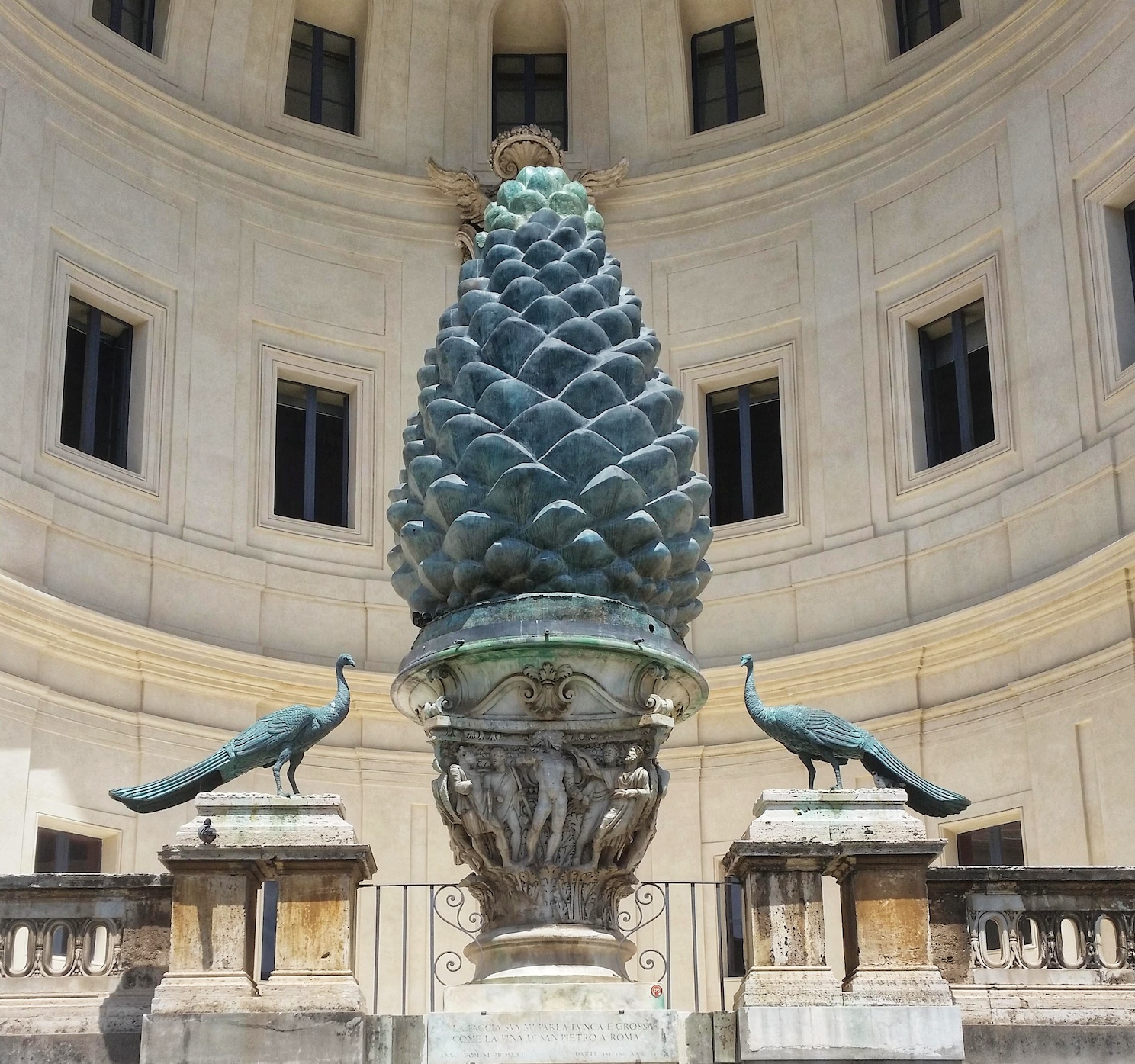
Rome is a city of fountains, and magnificent monuments to the power of water lurk round every corner. The massive size of the ancient metropolis was only made possible because of the series of aqueducts that brought vast quantities of water flowing into the urbs from the surrounding countryside, and the extraordinary resurgence of the city in the 16th and 17th century was largely down to the ancient water supplies being restored after centuries of damage and neglect - as a result the Baroque era was a golden age for the fountain in the Eternal City, and many of the city’s most memorable monuments came into being to feed Rome’s insatiable liquid appetite. From ancient sculptures to the grand Baroque ensembles of Gianlorenzo Bernini and playful modern creations it’s nigh on impossible to choose a favourite, but read on for our selection of 16 of tour favourite beautiful fountains in Rome.
1. Fontana di Trevi (Trevi Fountain)
Piazza di Trevi

Instantly recognisable and at the top of most people’s lists of must-see attractions in Rome, the iconic Trevi Fountain is an awe-inspiring masterpiece of Baroque sculpture. Although the fountain was built in the 18th century, the site has a long association with water. The Aqua Virgo, constructed in 19 BC, was one of the ancient city’s most important water supplies. Damaged by Gothic invaders in the 6th century, the decline of the aqueduct mirrored the decline of the city itself.
Restoring the city’s ancient water sources heralded Rome’s resurgence in the Renaissance, and Leon Battista Alberti helped renovate the Aqua Virgo aqueduct in 1453. After doomed projects involving great artists such as Gianlorenzo Bernini and Pietro da Cortona came to nothing, in the 1730s Pope Clement XII finally hired the Roman architect Nicola Salvi to provide a fitting Baroque monument to showcase the now rechristened Acqua Vergine.
Salvi came up with a brilliant design that fused the massive classical façade of the Palazzo Poli behind with the new organic form of the immense fountain, a mountain of porous Travertine stone fully 86 feet high and 160 feet wide. In Salvi’s epic masterpiece of ancient mythology, the sea-titan Oceanus advances towards us from a central niche directing the flow of the gushing waters as seahorses and tritons cavort all around him, whilst fake cliffs tumble down from the palazzo and into the square below.
2. Fontana dei Quattro Fiumi (Fountain of the Four Rivers)
Piazza Navona

There’s nowhere in the world quite like extraordinary Piazza Navona. Rome’s greatest public space, a one-time ancient racetrack transformed into a thrilling piece of street theatre, the square is dominated by the work of the twin geniuses of the Italian Baroque. The flamboyant church of Sant’Agnese in Agone was designed by Francesco Borromini, whilst the spectacular Fountain of the Four Rivers was created by his rival Gianlorenzo Bernini. Commissioned by the Pamphilj Pope Innocent IX as part of the family’s attempt to transform the piazza into an epic monument to themselves, Bernini’s jaw-dropping fountain is perhaps the Baroque monument par excellence.
Amidst the rushing waters personifications of the four great world rivers known to the 16th-century world lounge on rocky crags that support a massive ancient Egyptian obelisk above - the Nile, the Ganges, the Danube and the River Plate. Each of the four rivers are fascinating sculptures in their own right, but the personification of the Nile is perhaps the most interesting. The Nile covers his face with a veil - some say because he fears that Borromini's church will topple over and crush him, others because he is overcome by the architect's genius. More likely it is because the source of the Nile was unknown, an enduring mystery geographical mystery immortalised in stone…
3. Fontana delle Tartarughe (Turtle Fountain)
Piazza Mattei

In a city of stunning squares, Piazza Mattei can stake a convincing claim to being the most charming of them all. The centrepiece is the wonderful Fontana delle Tartarughe (Turtle Fountain). Designed by Giacomo della Porta and executed by Taddei Landini, the ensemble of sinuous young men and dolphins was, according to popular and fictitious legend, constructed in a single night in 1585. The story goes that the gambling-addicted Muzio Mattei had the feat pulled off after his wedding had been cancelled in an attempt to prove to the father of the bride that he was no mere wastrel. "Here's what a hard-up Mattei can achieve in just a few hours!" Muzio apparently crowed to his dumbstruck future father in law.
The real story is altogether less savoury. The fountain was originally commissioned to provide water to the residents of the recently established Jewish Ghetto, but the Mattei Duke (who controlled the entrance gates to the quarter) quickly requisitioned the monument and had the planned fountain moved to his nearby property instead. The Ghetto would have to wait a decade before they finally got their water source via another fountain designed by della Porta, which you can still see today in Piazza delle Cinque Scole. In the 1650s, Baroque master Gianlorenzo Bernini added the sweet little turtles climbing into the basin, lending the fountain the moniker by which we know it today.
4. Fontana del Tritone (Triton Fountain)
Piazza Barberini
View this post on Instagram
Triton, summoned from far down under, with his shoulders barnacle-strewn, loomed up above the waters…” Dominating Rome’s ever-chaotic Piazza Barberini is the great Baroque sculptor Gianlorenzo Bernini’s haunting fountain of Triton, commissioned by the all-powerful Barberini Pope Urban VIII in 1642. Amidst a dizzying swirl of moving water, dolphins and shells, the Greek sea god Triton rises high above the piazza and blows a conch that sends a foamy column of water into the blue skies above. The statue was Bernini’s first attempt at a free standing city fountain, and was built as a water outlet for the Acqua Felice aqueduct that had been restored by pope Urban to provide fresh water for the growing city. The leafy and aristocratic suburb the fountain originally called home is now unrecognisable, one of Rome’s busiest thoroughfares. But Bernini’s Triton stands proudly impervious to the passing centuries, dead marble brought dramatically to life by the chisel of a genius.
5. Fontana delle Api (Fountain of the Bees)

Via Vittorio Veneto
A diminutive but perfectly formed addition to our list, the Fountain of the Bees is another creation by Gianlorenzo Bernini, but not on the monumental scale of his other entries here. Situated at the base of ultra well-heeled Via Vittorio Veneto, the shell-shaped fountain is, you guessed it, decorated with beautiful sculpted aphids, instantly recognisable symbol of the omnipresent Barberini clan. The little fountain had a practical function, designed to collect the returning water from the nearby Triton fountain in the centre of Piazza Barberini, and doubled as a water trough for horses. Brought to fruition in 1644, the dedicatory inscription lauds the commitments of the Barberini Pope Urban VIII to beautifying the city with artistic commissions.
6. Fontana dei Libri (Fountain of the Books)
Via degli Staderari

One of our favourite lesser-known fountains in Rome is the Fontana dei Libri - the Fountain of Books - just a few steps from Piazza Navona. Designed by Pietro Lombardi in 1927, the fountain is the most modern entry on our list and pays homage to the San Eustachio district as a historical centre of learning - the first university in Rome, La Sapienza, opened its doors right here in the 1300s. The fountain’s central deer’s head refers to a legend about the eponymous Saint Eustace himself, a hunter to whom Christ spoke through the guise of a deer.
7. Fontana di Nettuno (Neptune Fountain)
Piazza Navona

Neptune battles a sea monster in Piazza Navona as the marvellous architecture of Francesco Borromini's church of Saint Agnes rears in the background. This is the fountain of Neptune on the north side of piazza Navona and is the least famous of the piazza's 3 major fountains. The basin was designed in 1574 by Giacomo della Porta, as a drinking fountain. Only 300 years later in the 1870s did the fountain become adorned with this dramatic scene of liquid battle. The centrepiece is Antonio della Bitta’s Neptune, the god of the sea, who does battle with a giant octopus. Next to the god Gregorio Zappalà added a horse who beats desperately at the water with his hooves and a Nereid, or a sea nymph, who throws her head back desperately as she gazes upon the action.
8. Fontana dell’Acqua Paola (The Acqua Paola Fountain)
Via Garibaldi

Spectacularly situated high on the Janiculum hill and boasting extraordinary views over the city, the immense Fontana dell’Acqua Paola is one of Rome's most imposing fountains, for good reason known as Il Fontanone. Constructed in 1612 to commemorate the restoration of the Aqua Paola aqueduct during the reign of Pope Paul V, the aqueduct finally brought clean drinking water to the west side of the Tiber for the first time since antiquity. The monumental celebratory fountain was designed by Giovanni Fontana and Flaminio Ponzio, and takes the form of five massive arches welcoming five torrents of rushing water into the huge basin. Much of the marble used in the fountain was taken from the ancient ruins of the Temple of Minerva in the Forum of Nerva, whilst the beautiful pink granite columns were taken from Old St. Peter’s Basilica.
9. Fontana del Panteon
Piazza della Rotonda

Threatening looking dolphins spew forth a constant stream of water in the Fontana del Pantheon in front of the magnificent ancient temple that gives the fountain its name. The fountain was built in the late 16th century, whilst the severe dolphins were added over a century later when Pope Clement XI also added an ancient obelisk to the ensemble. The amazing Pantheon rears behind, with its misleading inscription: “Marcus Agrippa made it.” Agrippa did commission the original Pantheon, a temple to all the pagan Roman gods, but Hadrian completely rebuilt it to a new design in 126AD.
The Pantheon is the best preserved ancient Roman building of all, thanks to its early conversion to a church when the Roman Empire adopted Christianity. The French writer Stendhal marvelled in the 1800s that he had never met anyone who wasn’t overcome with emotion at the first site of the Pantheon, which touched the level of the sublime. It’s hard not to be jealous of that 300 year old dolphin, who gets to gaze upon its beauty for all eternity…
10. Fontana della Barcaccia
Piazza di Spagna
View this post on Instagram
The square at the foot of the Spanish Steps is dominated by one of the city’s most charming fountains. Known as the Fontana della Barcaccia (little boat), the fountain predates the Steps by about a century and is the work of Pietro Bernini – the father of Baroque master Gianlorenzo, who gave his dad a hand in some of the decorative detailing. The fountain takes the unusual form of a partially sunken boat, and owes its genesis to a legendary event that took place during the devastating Christmas day flood of 1598.
The story goes that the Tiber’s flood waters rose so high that they carried a barge all the way from the river as far as Piazza di Spagna. Having reached so far into the city’s historic centre, the floodwaters miraculously receded. 30 years later, the Barberini Pope Urban VIII commissioned Bernini to mark the spot with a fountain – look out for the Barberini’s heraldic bees decorating the boat. The semi-sunken nature of the fountain also proved to be an ingenious solution to a thorny problem that had long frustrated attempts to build a grandiose fountain in the area – the stubbornly low water pressure that made impressive jets of water impossible to achieve. Bernini’s design transformed an apparently intractable shortcoming into an essential feature of the fountain.
11. Fontana della Navicella
Via della Navicella

The Barcaccia isn’t the only Roman fountain that takes the shape of a ship. Outside the magnificent church of Santa Maria in Domnica (whose apse mosaic is one of the finest medieval artworks in the city), the centrepiece of the Fontana della Navicella is a beautiful sculpture depicting an ancient Roman warship in miniature. Commissioned by the powerful cardinal Giovanni de’ Medici from the sculptor Andrea Sansovino in 1519 (you can see the Medici coat of arms on the base), the sculpture was probably a copy of an ancient original sculpture of the same theme that was created as an ex-votive offering by sailors stationed nearby invoking the gods to protect them on their voyages. The statue was only transformed into a fountain in the 1930s, when the previously sleepy quarter was redeveloped.
12. Fontana della Pigna
Cortile della Pigna, Vatican Museums

What’s a massive bronze pinecone doing at the heart of the Vatican’s most important courtyard? Incredibly this unusual sculpture is nearly 2,000 years old. It was probably originally cast as the centrepiece of a public fountain in the centre of ancient Rome. Rediscovered buried deep beneath the city in the Middle Ages, it was given pride of place in the atrium of Old St. Peter’s basilica. When the church was torn down to make way for the basilica we know today the pinecone was moved here, to Donato Bramante’s iconic Belvedere Courtyard, and set up once more as the centrepiece of a fountain. The two beautiful peacocks that flank it originally adorned Hadrian’s mausoleum. Peacocks were symbols of immortality in the ancient world, and they are definitely appropriate here - the Pinecone seems destined to live forever!
13. Fontana degli Artisti
Via Margutta

Located on stunning Via Margutta just a few strides from the Spanish Steps, the fountain of the artists pays homage to the area as a long-standing hub of the Eternal City’s artistic community. In 1612 the famous Baroque painter Orazio Gentileschi set up his workshop here, and artists from all over the world have flocked to Via Margutta ever since, conferring upon it the nickname la strada degli artisti. Commemorating this rich heritage, the fountain was installed in 1927 and features easels and stools, compasses and antique masks as well as a bucket overflowing with paintbrushes and chisels at the very top.
14. Fontana delle Botte (Fountain of the Barrel)
Via della Cisterna

One of Rome’s quirkiest fountains, the Fontana delle Botte is hidden away in bustling Trastevere, and is an homage to the venerable and vital profession of the wine-seller. The fountain takes the distinctive form of a caratello, as the barrels used to transport wine in Rome were historically known. A tap in the centre of the barrel spews forth a stream of water that is collected in an open bucket below, representing the must vat central to the winemaker’s art. To the sides of the barrel are two carafes, whose shapes will be familiar to anyone accustomed to ordering house wine in Roman trattorie. The fountain was designed in 1927 by the architect Pietro Lombardi (also responsible for the Fontana degli Artisti and Fontana deli Libri), and pays tribute to Trastevere’s traditionally central role in the sale of wine and hospitality in the Eternal City.
15. Fontana dell’Acqua Felice (Fountain of the Acqua Felice)
Piazza di San Bernardo

One of the grandest and most prominent monumental fountains in the city, the Fountain of the Acqua Felice is also known to history as one of the Rome’s most embarrassing artistic failures. Commissioned to celebrate the restoration of the Acqua Felice aqueduct by Pope Sixtus V in 1588, the monument was designed by the Pope’s chief engineer and architect Domenico Fontana, and marked the first monumental wall fountain to be constructed in Rome since ancient times. The fountain self-consciously refers to the achievements of antiquity, taking the form of an ancient triumphal arch with an inscription above lauding the achievements of the commissioning Pope. So far so good; but the problems arose when it came to the sculptural decorations of the fountain below.
At the centre of the ensemble is the figure of Moses, captured in the act of striking the rock at Meribah, where he caused water to miraculously flow from a stony cliff-face. The blunderingly out of proportion prophet was derided by the city’s cognoscenti as soon as it was unveiled, with one pasquinade describing how Moses himself ‘looks with a grim eye / At the water that rushes to his feet, / Horrified at the damage that has been done to him / By a sculptor who has lost his mind!’ Contemporary historians began a baseless rumour that the artist responsible, Prospero Antichi, died of shame as a result of the negative reception, but he had the last laugh - the statue is still standing in pride of place at one of Rome’s busiest crossroads more than 400 years later!
16. Fontana del Fachino (Fountain of the The Porter)
Via Lata

The final entry on our list is a much more humble affair, but the characterful Fontana del Facchino just off Via del Corso nonetheless has a fascinating history. The 16th century fountain takes the shape of an ‘acquaricciaro, a water carrier who would sell his precious cargo on the city streets from his barrel. Facchino has had a chequered history; he started life in the 1580s as one of Rome’s ‘speaking statues,’ marble mouthpieces for the citizenry’s satirical written denunciations of the elites, which would be anonymously posted on the statue in the dead of night. Once thought to have been the work of Michelangelo himself, according to popular legend he lost his nose when it became rumoured that the statue actually depicted Martin Luther, and local zealots took revenge on the reformer’s effigy. Battered and bruised, Facchino is still standing and dispensing water to thirsty travellers to this day - make sure to salute him as you pass by!
What did you think of our list? What are some of your favourite Roman fountains that we didn’t include?



